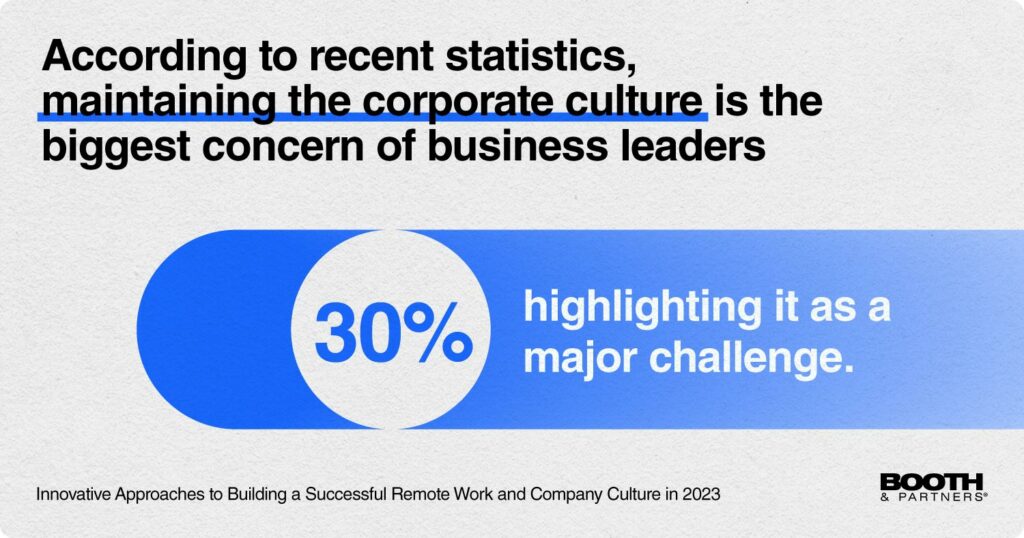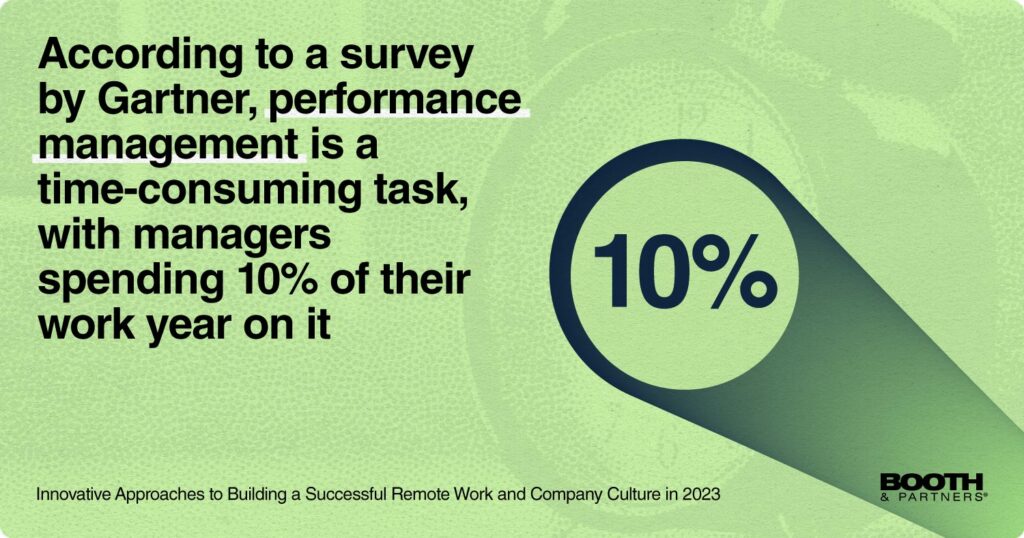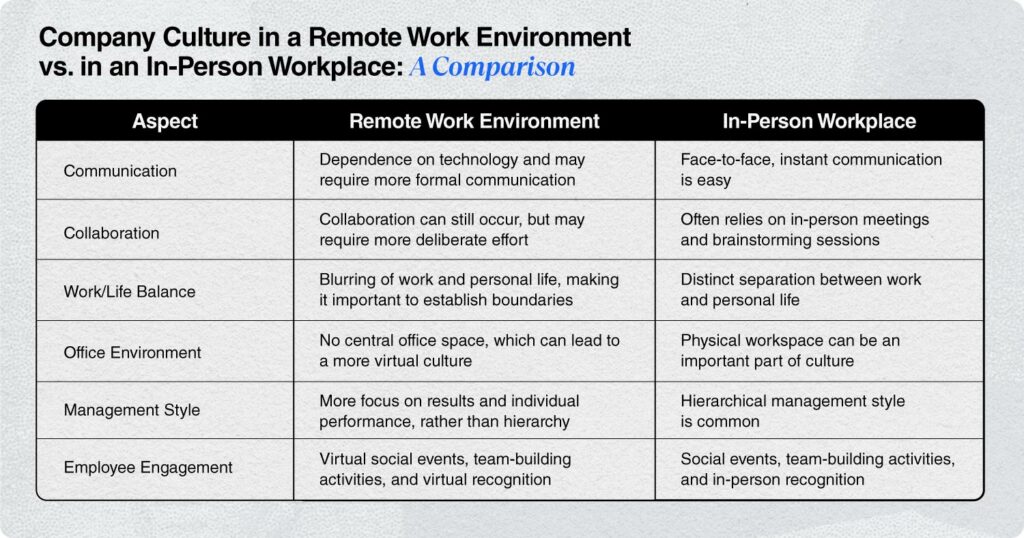Innovative Approaches to Building a Successful Remote Work and Company Culture in 2023

In recent years, remote work has become a popular alternative to traditional in-person workplaces. This trend has accelerated in response to the COVID-19 pandemic, as companies rapidly shifted to remote work arrangements to keep their employees safe.
However, remote work and company culture may not blend well together, as there is a common perception that positive work culture can only exist in in-person workplaces. This belief is now being challenged as statistics show that there are now three times more remote jobs compared to 2020.
With the growing popularity of remote work, it is essential for companies to consider how they can develop a resilient work culture that can thrive in a virtual space. In this blog, we will discuss innovative approaches to building a successful remote work and company culture. But let’s first understand the company culture in a remote work environment compared to an in-person workplace.
Company Culture in a Remote Work Environment vs. in an In-Person Workplace: A Comparison
The ideals, assumptions, and practices that influence an organization’s identity are referred to as its company culture. It is essential to establishing a productive workplace that promotes job satisfaction. The culture of a remote work environment may be quite different from that of an in-person workplace. Below is a side-by-side comparison of the two in terms of company culture:
In an in-person workplace, communication and collaboration can happen more spontaneously, and the physical office environment can play a significant role in company culture. In contrast, remote work requires more deliberate effort to establish communication and collaboration channels, and there is no central office space, which can lead to a more virtual culture.
Understanding the differences between the company culture of remote work and in-person workplaces is crucial for any organization’s success in various ways. It helps companies establish communication and collaboration channels, recognize the need for work-life balance, and find new ways to engage employees.
Syncing Remote Work and Company Culture: How to Effectively Develop a Corporate Culture in a Virtual Space?

This concern is amplified in remote work settings where building and preserving company culture can be particularly daunting. In this section, we will explore effective strategies for developing and communicating a strong corporate culture in a remote work environment.
1. Define your corporate culture
Start by outlining the core principles of your organization. This includes determining what matters to your business and how you want remote workers to view the organization.
2. Communicate regularly
In any work from home setup, communication is essential. To keep everyone connected and informed, schedule frequent team meetings, one-on-one conversations with staff, and town hall gatherings.
3. Create a solid onboarding process
A solid onboarding procedure aids new remote employees in feeling welcomed and a part of the company’s culture right away. Use video conferencing capabilities to hold online orientation sessions and send welcome packages with business merchandise to remote workers.
4. Foster a sense of community
Encourage a sense of community among remote workers by holding social gatherings, virtual team-building exercises, and online chat rooms.
5. Create a program for recognizing accomplishments
Establish a program for recognizing the toil and success of remote workers. Use online award ceremonies, team meeting shoutouts, and personalized letters to express your gratitude.
6. Stimulate cooperation
Increase cooperation between remote employees by employing tools for cooperation, including project management software and video conferencing systems.
7. Create a remote work policy
Implement policies that set requirements for remote workers, including communication standards, deadlines for output, and performance evaluations.
8. Set an example
Adopt remote work and embody the company’s culture and principles in your actions and behavior. This establishes the tone for the entire company and demonstrates to remote workers their importance to the team.
How to Overcome Communication Barriers and Promote Effective Communication Among Remote Teams?
Effective communication is a cornerstone of a positive work culture. When employees can communicate clearly and effectively, they can collaborate and work together towards common goals. However, according to a study of 61,000 Microsoft employees, remote work can create communication barriers between different teams. So, let’s discuss some strategies that remote teams can use to overcome communication barriers and promote effective communication.
1. Use the appropriate communication tools
Remote teams should make use of the tools most appropriate to their communication requirements. For remote teams, email, video conferencing, instant messaging, and project management applications are all useful, but it’s important to select the appropriate technology for the job. For team meetings and brainstorming sessions, for instance, video conferencing could be preferable, while instant messaging might be ideal for fast inquiries and updates.
2. Establish communication standards
When working remotely, establishing transparent communication standards is a must. These protocols should specify how and when team members will communicate with one another, as well as the tools they will employ and the data they must exchange. This will reduce the likelihood of miscommunication among remote teams.
3. Set deadlines for responses
Decide on deadlines for emails, text messages, and other kinds of communication. This guarantees that team members won’t have to wait around while planning their tasks.
4. Leverage visual aids
Diagrams, graphs, and charts can all be used to better communicate difficult information. This is necessary for remote teams whose primary means of communication is digital.
5. Schedule regular check-ins
Plan regular check-ins with the team to discuss the team’s progress and any challenges that arise. By doing this, it is possible to ensure that everyone is in agreement and that any difficulties can be resolved before they escalate.
6. Encourage active listening
Motivate team members to pay attention to one another and explain any misunderstandings by asking questions. This will minimize confusion and ensure that everyone understands the same information.
7. Avoid using acronyms and jargon
Steer clear of acronyms and jargon that not all team members may be familiar with. This helps prevent miscommunications by ensuring that everyone is aware of the same information.
8. Facilitate training on effective communication
Give everyone on the team training in effective communication. This can involve instruction on how to properly use communication tools, compose messages that are clear and succinct, and communicate during virtual meetings.
Managing Performance in a Remote Setting: Effective Performance Management Techniques for Remote Employees
In the context of remote work and company culture, effectively managing the performance of employees in virtual spaces has become an increasingly important concern for organizations.

However, this top-down approach may not effectively involve remote employees in the process. Therefore, organizations need to adopt the following effective performance management techniques that are suitable for remote employees.
1. Clear performance objectives and goals
In a remote work environment, having specific and well-defined performance goals and targets is necessary. It is crucial to make sure that remote workers are aware of their obligations and know what is expected of them. These objectives and goals should also be quantifiable so that management can track development and offer feedback.
2. Regular performance evaluations
The conduct of regular performance reviews is substantial in evaluating the effectiveness of remote employees. These reviews should be carried out by managers on a regular basis, such as every quarter or every two years. They should assess how remote employees performed in comparison to previously established goals and objectives, talk about their strengths and areas for improvement, and create new performance objectives for the next term.
3. KPIs and metrics
Another useful method for managing employee performance in a remote work environment is to measure performance using metrics and KPIs. Managers can assess the performance of remote workers using indicators like productivity, quality, and efficiency. Software for project management can help track these metrics.
4. Self-evaluation
A unique way of evaluating the effectiveness of remote workers is to encourage them to evaluate their own performance. Regular check-ins or surveys can be used for this, in which remote workers assess their own performance and give feedback on their strengths and weaknesses.
5. Peer review
Peer reviews are a useful tool for assessing employee performance in remote work environments. Through collaboration tools like online chat or video conferencing, managers can encourage remote workers to give feedback to one another. This method can also offer insightful information about the areas where remote workers flourish and those where they need to improve.
6. Performance-tracking software
Managers may evaluate employee performance in a remote work environment by using performance-tracking software. These tools give managers the ability to monitor metrics and KPIs, assess development in relation to goals and objectives, and give feedback to remote workers.
7. Team performance evaluation
Evaluating the performance of the entire remote team could also be an effective method of managing the team’s overall performance. Monitoring metrics like team productivity, efficiency, and quality allows managers to assess the effectiveness of their teams. This might show the team where they are thriving and where they need to improve.
8. Performance-based rewards
Finally, in a remote work environment, performance-based rewards can be a strong motivator. Managers can provide rewards for remote workers who meet their performance goals and objectives, such as bonuses, promotions, or recognition. This can help increase motivation and encourage remote employees to perform at their best.
Build a High-Performing Remote Team in the Philippines and Colombia
Building a successful and sustainable remote work culture can be difficult for businesses for several reasons. One of the primary challenges is maintaining effective communication and collaboration among team members who may be located in different time zones. But you can overcome these challenges by partnering with Booth & Partners, a leading staff leasing company that offers the best talent and quality solutions for offshore teams based in the Philippines and Colombia.
Booth & Partners operates in a time zone that overlaps with many other regions, making it easier to maintain communication and collaboration across the team. Our highly-trained professionals are also familiar with Western business culture, making it easier to establish trust and accountability. Also, we’re Great Place to Work® Certified™– the most desirable recognition for companies seeking to become an employer of choice.
We’re not just the perfect extension of your in-house team. Our company could also free up your time to concentrate on the core areas of your business, as we handle all your administrative tasks. With our employer of record (EOR) model, we can manage all aspects of your business operations, from recruitment and onboarding to training, compliance, taxes, benefits, payroll, and other related matters.
Are you ready to start outsourcing to optimize your operational efficiency? Then, click here to get a quote, or contact us for a quick discovery call.
Discover more about outsourcing and
how you can maximize it for your
business success!
Get a copy of our E-book: Guide to Outsourcing.




